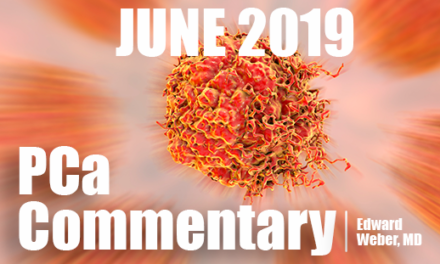
PCa Commentary | Volume 142 – January 2020
Posted by Edward Weber | January 2020
ANTI-TUMOR IMMUNE RESPONSE POTENTIATED by RADIOTHERAPY:
A concept arising from pre-clinical studies is now clinically supported by the results of the ORIOLE trial.
The ORIOLE TRIAL, “Primary Outcomes of a Phase II Randomized Trial of Observation Versus Stereotactic Ablative Radiotherapy for Oligometastatic Prostate Cancer,” Phillips et al., Int. J. Radiation Oncology Biology Physics, November 1, 2019.
The study had two objectives:
First, to evaluate the outcome in 52 men following primary radiotherapy or surgery who presented with recurrent metastatic hormone-sensitive prostate cancer in three or fewer lesions (bone or lymph nodes) based on the initial findings on CT and bone scans. Randomization was 2:1 with the larger group receiving SART to the metastatic sites versus observation only in the comparator group. The groups were matched for similar characteristics. Query: Would SART prolong progression in the treated sites or at distant sites as compared to untreated men?
The 6-month endpoint was disease progression in the treated lesions, and, importantly, the assessment of the development of new distant lesions. Progression was declared at a 25% increase in PSA or by evaluation using strict criteria for radiographic progression. No ADT was administered.
Secondly, the researchers acquired pretreatment imaging and genomic data to support an interpretation of the biologic mechanism that might explain any prolongation of progression-free survival in the treated group—if in fact that was the study finding. The ancillary imaging (not considered in the primary findings) included a 68Ga-PSMA -11 PET/CT in each of the 52 men. Those results were subdivided into subsets in which the PET/CT imaging found no additional lesions and those in which the PSMA scan found additional lesions compared to the baseline CT/bone scans.
An analysis of T-cell activation was performed in the hope of discovering biomarkers predicting which patients in the future might respond to radioablation of metastatic sites.
Findings:
Executive Summary: At 6 months, in all parameters of analyses the outcome of the SABR treated men was markedly superior to the observation group:
Details: Progression at 6 months: treated vs. non-treated, 19% vs. 61% (p=0.005).
Median progression-free survival with SABR: not reached vs. 5.8 months for observation.
Of the 35 men in the SART group who had pre-treatment PSMA scans, those who showed total consolidation of those lesions at on a 6-month follow-up scan were 16% less likely to develop new distant lesions than those men with incomplete resolution, 63%. Freedom from distant metastases was 29 months vs. 6 months for untreated men. (A demonstration of the abscopal effect)
Basic immunobiology: The ‘abscopal” effect (ab scopes, Latin for action at a distance):
What immunologic mechanism might explain the retardation of the appearance of lesions at a distance from the treated SABR targets? This question leads into discussion of the “abscopal” effect.
Brief review:
Many cancer cells generate a defense against T-cell attack by expressing a protein, PD-L1 (Programmed Death-Ligand 1) on the cell surface, and secrete this cytokine into their immediate environment. When PD-L1 mates with its receptor, PD1, on cytotoxic T-cells, the T-cell killing function is suppressed or lessened. This PD-L1/PD1 mating creates the so-called “checkpoint.” The several newly developed drugs that interrupt this mating are termed “checkpoint” inhibitors, i.e., Ketruda, Yervoy, Opdivo, etc.
Cytotoxic T-cells are designed to seek surface proteins on cancer cells, create a lethal pore, and destroy the cancer cell. Some cancers express more target proteins than others (notably melanoma and lung cancer). Unfortunately, unselected prostate cells have a low expression of these target proteins. Notable exceptions are those prostate cells with defects in DNA damage repair (i.e. those with BRCA and PARP mutations) and some very high-grade prostate cancers—Gleason pattern five and intraductal adenocarcinoma.
In the major clinical trial, KEYNOTE-028, of men with mCRPC whose cells expressed >1% PD-L1, the checkpoint inhibitor pembrolizumab (Keytruda), showed a 13% objective response; 39% had a stable disease lasting 12 months.
An excellent review of this general subject is “PD-1/PD-L1Pathway inhibitors in Advanced Prostate Cancer,” Isaacsson & Antonarakis, Expert Rev Clin Pharma. 2018 May.
What can be done to enhance immunotherapy of prostate cancer so as to treat prostate cancer more effectively?
In the ORIOLE trial, SART enhanced the immunologic response, presumably by exposing additional neo-antigens to killer T-cells. This mechanism might have explained the retardation of new lesions at a distance (the “abscopal” effect) from the SABR targets.
Perhaps the next step will be combining radiotherapy (as evaluated in the ORIOLE trial) with checkpoint inhibitor therapy, such as Ketruda or Opdivo, thus protecting the killer T-cell from functional suppression by the obstructing PD-L1/PD1 checkpoint. This is the direction of new research.
CLINICAL TRIAL—NCT 02489357:
Sponsors: Johns Hopkins and NCI; Expected Study Completion Date, Nov 2017
Principal Investigator: Emmanuel Antonorakic:
“Pembrolizumab and Cryotherapy in Treating Patients with Newly Diagnosed Oligo-Metastatic Prostate Cancer.”
https://clinicaltrials.gov/ct2/results?cond=&term=02489357&cntry=&state=&city=&dist= [control+click link or visit www.clinicaltrials.gov & enter NCT number in Other terms section]
This protocol captures the essence of the concepts discussed above and serves as an example for the many forthcoming trials in prostate cancer. Quoted below is the brief summary of the trial from ClinicalTrials.gov:
- “This pilot phase ll trial studies the side effects and how well pemprolizumab [“Ketruda’] and cryosurgery work with short term androgen ablation to treat patients with prostate cancer that has traveled from the original tumor, through the body, and formed a small number of new tumors in other parts of the body (oligo-metastatic). Cryosurgery, also known as cryoablation or cryotherapy, kills tumor cells by freezing them. The process also incites an immune response within the ablated tumor. Giving monoclonal antibodies such as pembrolizumab which enhance a systemic anti-cancer immune response, may augment the effects of cryotherapy and increase tumor killing at distant (metastatic) sites,” [the “abscopal” effect.]
BOTTOM LINE:
With regimens incorporating these concepts, we may be seeing the emergence of a new therapeutic regimen for the treatment of prostate cancer.
Your comments and requests for information on a specific topic are welcome e-mail ecweber@nwlink.com.
Please also visit https://prostatecancerfree.org/prostate-cancer-news for a selection of past issues of the PCa Commentary covering a variety of topics.
“I want to thank Dawn Scott, Staffperson, Tumor Institute Radiation Oncology Group, & Mike Scully, Librarian, Swedish Medical Center for their unfailing, timely, and resourceful support of the Commentary project. Without their help this Commentary would not be possible.”
ABOUT THE AUTHOR
Edward Weber, MD, is a retired medical oncologist living in Seattle, Washington. He was born and raised in a suburb of Reading, Pennsylvania. After graduating from Princeton University in 1956 with a BA in History, Dr. Weber attended medical school at the University of Pennsylvania. His internship training took place at the University of Vermont in Burlington.
A tour of service as a Naval Flight Surgeon positioned him on Whidbey Island, Washington, and this introduction to the Pacific Northwest ultimately proved irresistible. Following naval service, he received postgraduate training in internal medicine in Philadelphia at the Pennsylvania Hospital and then pursued a fellowship in hematology and oncology at the University of Washington.
His career in medical oncology was at the Tumor Institute of the Swedish Hospital in Seattle where his practice focused largely on the treatment of patients experiencing lung, breast, colon, and genitourinary cancer and malignant lymphoma.
Toward the end of his career, he developed a particular concentration on the treatment of prostate cancer. Since retirement in 2002, he has authored the PCa Commentary, published by the Prostate Cancer Treatment Research Foundation, an analysis of new developments in the prostate cancer field with essays discussing and evaluating treatment management options in this disease. He is a regular speaker at various prostate cancer support groups around Seattle.





